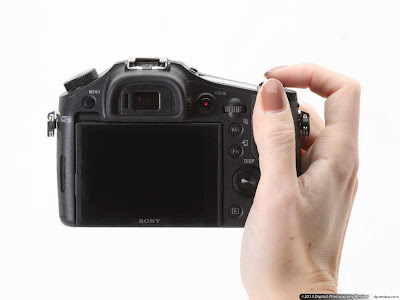Interesting New Camera, Old Ergonomic Problems
The Universal Camera The Sony RX10 caused a fairly large wave of interest among enthusiast photographers when it was announced just a few days ago. On the specifications, it comes perhaps closer than any previous model from any maker to the universal, do everything wunderkamera so lusted after by those of us who really don't like changing lenses. Check the star points:
* Constant f2.8 lens covering a diagonal angle of view of 84 degrees at the wide end to 12 degrees at the long end. This replicates the aperture and angle of view range of the classic professional photographer's 24-70 and 70-200mm f2.8 zooms for the full frame 43mm diagonal sensor. The extra good news is you never have to change lenses.
* Decent image quality. The RX10 apparently uses the same 15.9 mm diagonal sensor as the RX100Mk2, which has a DXO Mark score of 67. This puts it right in the middle of current Canon APS-C and M43 cameras on technical image quality, at least at the lower end of the ISO range.
* It has a largish handle so you can grip it firmly. It certainly needs one with a mass of 813 grams including battery.
* High resolution EVF.
* Swing up/down monitor of good quality.
* Sony is claiming very good performance for focussing and image throughput.
So has the ultimate wunderkamera been delivered unto us ?
In a word, no.
The problem is ergonomics. The reason I continue to write this blog is that the world is awash with cameras, many of which feature good enough picture quality and performance but compromised ergonomics. The RX10 is just one of the latest.
There are two main ergonomic issues which I can see from the promotional photographs, particularly photos of someone holding the camera.
Location of the shutter button I have thus far seen only one reference to this problem in early, hands on reviews of the RX10. This is from Dave Etchells of Imaging Resource who wrote "......I found myself having to reach back a bit to get my index finger on the shutter button...." and "...there wasn't much of a choice for any other way to do it...."
My comment about this is:
a) He is absolutely right in pointing out that the shutter button is not where his right index finger wanted to find it.
b) On my analysis he is altogether too pessimistic in thinking there is nothing to be done about it.
 |
| X marks where the shutter button needs to go |
My interest in camera ergonomics was sparked several years ago by the Panasonic Lumix G1. This was the world's first mirrorless interchangeable lens camera. I found it's ergonomics distressingly poor. Fortunately Panasonic has lifted it's game since 2008 and current model Lumix M43 cameras are among the best on the market for ergonomics, and most other things as well.
One of the problems with the G1 was the location of it's shutter button on the tip of a thin projecting type handle. The RX10 repeats exactly the same problem. The shutter button needs to be located where the distal phalanx of the right index finger wants to find it, as indicated on the photographs. Sony has no excuse for putting the shutter button in such an awkward place. They could easily put in the optimal position. Doing so would free up more space on top of the camera and allow a more effective configuration of buttons plus the inclusion of a top/front control dial.
Thumb position and thumb support, relationship to rear control dial.
This ergonomic error is a little more subtle and is one made by several manufacturers. When holding a camera the right thumb wants to lie diagonally across the back of the camera, not cramped up at the extreme right hand side. The RX10 requires this cramped position which provides a less secure grip on a fairly weighty camera than would be provided if the thumb could angle across in a more natural position. Please refer to the attached photos for further description about this.
Summary The Sony RX10 is one of the most interesting cameras to hit the market in my 60 years experience with photography. Really. It's potentially a game changer for the entire camera industry. The evolution of cameras like this could turn interchangeable lens cameras into a niche product. I have been predicting the arrival of such a product for some time.
But Sony's designers need to go to ergonomics school and learn some basic principles. Or they could read the first 20 or so posts in this blog. If they do that, and correct the ergonomic mistakes of the RX10 next time round, they will have a mighty strong product with wide appeal to many enthusiast/expert and amateur photographers, maybe even some professionals.



